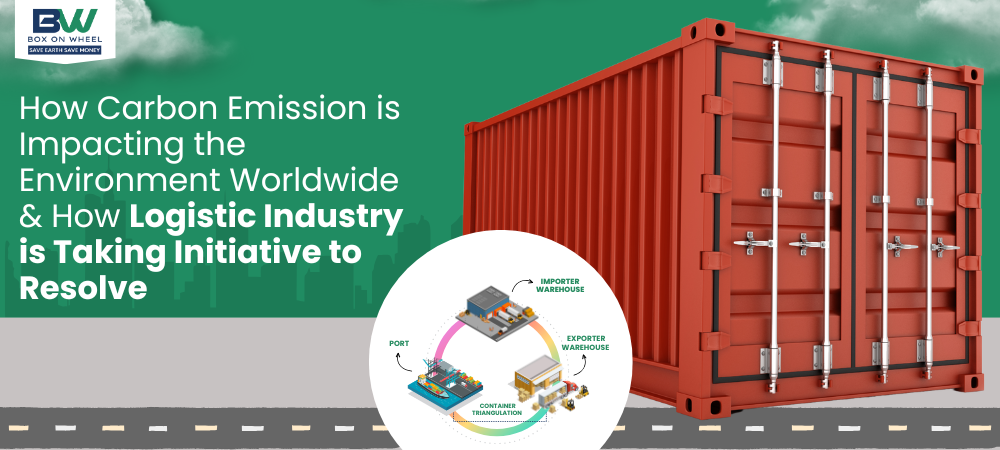Carbon emissions have become a major environmental issue, affecting both the planet and human health. The logistics industry, which transports goods globally, produces about 8% of global greenhouse gas emissions. The rising demand for goods and services adds pressure on this industry to adopt sustainable practices. Reducing carbon emissions in logistics is important for slowing climate change and preserving environmental health.
Carbon Emissions in the Logistics Industry
The logistics industry is a key player in carbon emissions. Logistics includes the movement of goods by air, sea, and road, all of which consume fuel and produce carbon emissions. In some countries, logistics accounts for a significant portion of emissions; for example, it accounts for 27% of greenhouse gas emissions in the United States. If logistics companies continue current practices, this sector may become one of the largest sources of emissions by 2050. This makes it essential to find solutions that allow goods to move efficiently while reducing carbon output. The logistics sector’s large carbon footprint has led to an exploration of new methods to cut emissions.
What Is Container Triangulation?
Triangulation is a logistics strategy that reduces empty trips by optimizing container movements. Normally, a truck or container returns empty after dropping off goods. This increases unnecessary fuel use and emissions. Triangulation changes this by finding nearby loads that can fill empty trucks or containers, minimizing the need for extra trips. For example, a container that has delivered goods to a port can then be directed to pick up goods from a nearby location instead of returning empty. This strategy requires advanced data analytics to determine the best routes and coordinate cargo pickups and deliveries efficiently. Triangulation, therefore, not only reduces emissions but also improves the overall efficiency of logistics.
Carbon Savings Through Triangulation
One main benefit of triangulation is its potential to reduce carbon emissions significantly. Studies show that optimizing container movements through triangulation can reduce emissions by up to 30%. By minimizing empty trips, logistics companies can save about 20% in CO₂ emissions for each trip. For perspective, a typical container truck emits 60 to 150 milligrams of CO₂ per kilogram per kilometer. Reducing these empty trips can lead to considerable annual savings in carbon emissions, often lowering a single truck’s footprint by around 12.5 metric tons of CO₂.
Environmental Benefits of Triangulation
The environmental benefits of triangulation extend beyond direct carbon reductions. By cutting down on empty trips, triangulation lowers fuel consumption, leading to fewer emissions. Additionally, optimized routing reduces congestion at ports and along transportation routes. This smoother flow of transport reduces traffic, which further cuts fuel consumption and emissions. Resource optimisation is another benefit, as better use of trucks and containers leads to less waste and improved supply chain efficiency. All these effects contribute positively to the environment, supporting global goals to combat climate change.
What Are The Challenges in Triangulation?
While triangulation has clear benefits, implementing it comes with several challenges:
- Coordination Complexity: Triangulation requires multiple parties, such as shippers, carriers, and port authorities, to coordinate effectively. This can be difficult and may slow down processes.
- Technological Requirements: Successful triangulation depends on advanced technologies like AI and Internet of Things (IoT) for real-time tracking. Not all logistics companies have the resources or expertise to implement these technologies.
- Regulatory Obstacles: Customs and regulatory requirements can make it difficult to reuse containers immediately for new shipments, which delays operations.
- Initial Costs: The cost of adopting new technology and training staff can be high. Smaller companies may find these upfront investments challenging to afford, which may discourage them from adopting triangulation.
Future Outlook for Carbon Reduction in Logistics
The logistics industry is gradually recognising the importance of sustainability. As more companies realize the benefits, triangulation and similar methods are likely to grow in popularity. Advanced technologies like AI and predictive analytics will further support triangulation by helping logistics companies identify optimal routes and improve operations. Governments may also begin supporting these efforts with incentives or regulations that encourage sustainable practices. Together, these advancements will make carbon reduction in logistics more achievable and cost-effective.
Conclusion
Reducing carbon emissions in logistics is much needed for combating climate change. The logistics industry contributes heavily to greenhouse gas emissions, making it essential to adopt sustainable methods. Triangulation represents an effective strategy to reduce unnecessary trips, saving fuel and lowering emissions. As sustainability becomes more central to business strategies, logistics will likely embrace triangulation and other innovations more widely. With these efforts, the industry can reduce its carbon footprint and help create a healthier environment for future generations.
Source
[1] https://www.dailypioneer.com/2024/columnists/green-logistics-is-an-environmental-imperative.html [2] https://dahnay.com/the-promise-of-container-triangulation-in-global-supply-chains/ [3] https://www.transmetrics.ai/blog/logistics-sustainability/ [4] https://www.atechlogistics.com/7-ways-to-lower-your-carbon-emissions-in-trucking-logistics/ [5] https://www.bridgenext.com/blog/sustainability-in-transportation-and-logistics-a-data-driven-journey/ [6] https://timesofindia.indiatimes.com/blogs/voices/navigating-indias-logistics-sector-towards-sustainable-future-strategies-for-carbon-emission-reduction/

